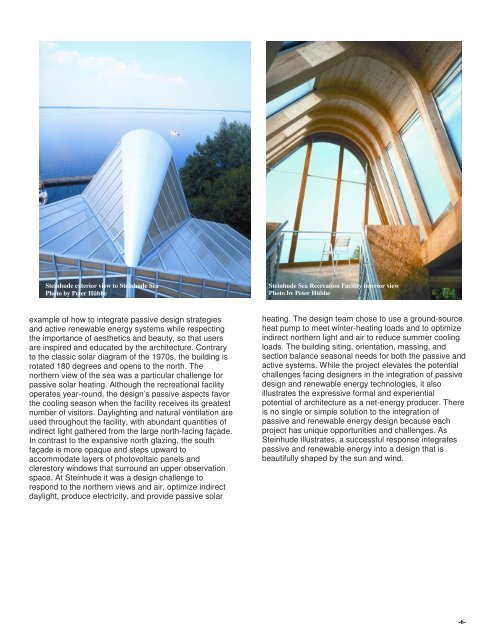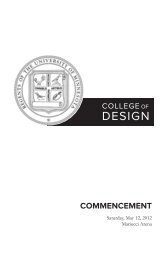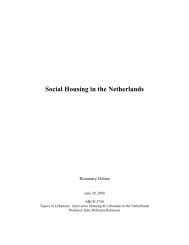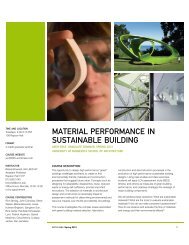THE NEW ARCHITECTURE OF THE SUN AND WIND: - School of ...
THE NEW ARCHITECTURE OF THE SUN AND WIND: - School of ...
THE NEW ARCHITECTURE OF THE SUN AND WIND: - School of ...
Create successful ePaper yourself
Turn your PDF publications into a flip-book with our unique Google optimized e-Paper software.
Steinhude exterior view to Steinhude Sea<br />
Photo by Peter Hübbe<br />
Steinhude Sea Recreation Facility interior view<br />
Photo by Peter Hübbe<br />
example <strong>of</strong> how to integrate passive design strategies<br />
and active renewable energy systems while respecting<br />
the importance <strong>of</strong> aesthetics and beauty, so that users<br />
are inspired and educated by the architecture. Contrary<br />
to the classic solar diagram <strong>of</strong> the 1970s, the building is<br />
rotated 180 degrees and opens to the north. The<br />
northern view <strong>of</strong> the sea was a particular challenge for<br />
passive solar heating. Although the recreational facility<br />
operates year-round, the design’s passive aspects favor<br />
the cooling season when the facility receives its greatest<br />
number <strong>of</strong> visitors. Daylighting and natural ventilation are<br />
used throughout the facility, with abundant quantities <strong>of</strong><br />
indirect light gathered from the large north-facing façade.<br />
In contrast to the expansive north glazing, the south<br />
façade is more opaque and steps upward to<br />
accommodate layers <strong>of</strong> photovoltaic panels and<br />
clerestory windows that surround an upper observation<br />
space. At Steinhude it was a design challenge to<br />
respond to the northern views and air, optimize indirect<br />
daylight, produce electricity, and provide passive solar<br />
heating. The design team chose to use a ground-source<br />
heat pump to meet winter-heating loads and to optimize<br />
indirect northern light and air to reduce summer cooling<br />
loads. The building siting, orientation, massing, and<br />
section balance seasonal needs for both the passive and<br />
active systems. While the project elevates the potential<br />
challenges facing designers in the integration <strong>of</strong> passive<br />
design and renewable energy technologies, it also<br />
illustrates the expressive formal and experiential<br />
potential <strong>of</strong> architecture as a net-energy producer. There<br />
is no single or simple solution to the integration <strong>of</strong><br />
passive and renewable energy design because each<br />
project has unique opportunities and challenges. As<br />
Steinhude illustrates, a successful response integrates<br />
passive and renewable energy into a design that is<br />
beautifully shaped by the sun and wind.<br />
-6-







